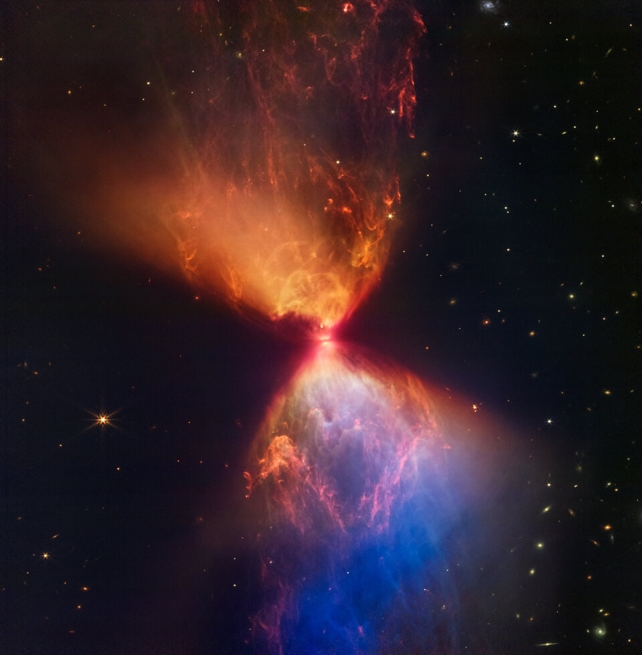Everywhere JWST looks in space, matter and energy interact in spectacular displays. Webb reveals more detail in these interactions than any other telescope because it can see through the dense gas and dust that obscures many objects.
In the new image, JWST captures a young protostar only 100,000 years old.
The star is called L1527, and at this young age it is still embedded in the molecular cloud that spawned it. This is one of the reasons NASA built JWST (with help from ESA and CSA). A telescope can see through dust and gas to reveal the earliest stages of star formation.
This image was taken with the MIRI, Mid-Infrared Instrument. A young protostar is at the heart of it all, and it’s still growing. It is accreting matter from the protoplanetary disk that surrounds it. The disk is the small dark horizontal line in the center of the image.
A protostar is not a main sequence star, so it does not undergo fusion like the Sun. There may be a small amount of deuterium fusion in its core, but it generates energy in a different way.
As the star’s gravitational pull pulls the material closer, the material is compressed and heated. More energy comes from shock waves generated by the incoming material colliding with the existing gas. This is the energy that illuminates the star and its surroundings inside the giant molecular cloud that spawned it.
As young protostars accumulate mass, they generate strong magnetic fields. Combined with the star’s rotation, these fields drive matter away from the star.
So as the protostar gains mass, some of it also ejects back into space in spectacular hourglass-shaped jets that emanate from the star’s poles. These jets create visible bow shocks in the material around the star, which are filamentary structures.
There are polycyclic aromatic hydrocarbons (PAHs) in the star’s environment. They are organic compounds abundantly found throughout the universe that may have contributed to the origin of life. The image glows blue, including fibrous structures.
The red region in the center is the thick layer of gas and dust surrounding the young star, illuminated by the star’s energy. The white area between the red and blue is a mixture of materials. There are more PAHs as well as ionized gases like neon and other hydrocarbons.
This is not the first time JWST has examined L1527. In 2022, it observed the protostar with its Near-Infrared Camera (NIRCam).

This beautiful demonstration of the interaction of matter and energy is transient.
Over time, the protostar’s powerful outbursts will clear its surroundings of much of the gas and dust, although it will still have its protoplanetary disk. Eventually, the star becomes a main sequence star that can be easily seen without the veil of gas and dust. By then, the star’s planetary system will be forming.
There are unanswered questions about protostar formation, and one of JWST’s main science goals is star formation. For example, astrophysicists do not know exactly how and when fusion is triggered and a protostar becomes a main sequence star.
Although astronomers know that there are strong magnetic fields around protostars, they do not know exactly how they form and what role they play in the collapse and rotation of the star.
JWST has made some progress on this issue. She recently confirmed that jets from young stars are aligned due to the star’s rotation and magnetic fields, something supported by theory but not yet confirmed by observation.
There are also uncertainties about how binaries form. Do they form just like lone stars? Why are so many stars binary?
The exact nature of the events that trigger star formation is also unclear. Shock waves from supernovae can trigger the birth of stars, but what about other cases? Is it just a matter of density?
The answers to these questions will continue to grow. With its ability to see more detail in young stars and the clouds of swirling gas and dust that surround them, JWST is progressing one image at a time.
This article was originally published by Universe Today. Read the original article.